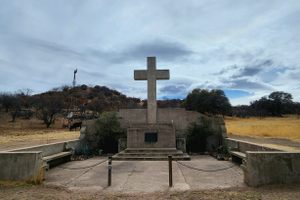
Marcos de Niza was born in Nice, which is today in France but was at the time part of the Duchy of Savoy, in approximately 1495. It is unknown whether Marcos was ethnically Italian or French – the Duchy of Savoy was a largely Italian state, but with a sizable French population. He would have likely originally been known as either Marco da Nizza or as Marc de Nice. He was ordained as a Franciscan priest in the Catholic Church, moved to Spain, and entered that country’s service. Adopting the language and naming customs of his new home, he became known as Marcos de Niza, which is the name history remembers him as.
In 1530, Marcos was dispatched to the new Spanish colonies in the Americas and traveled widely. He accompanied conquistadors in what would become Nicaragua, Peru, Ecuador, and Guatemala, serving as a priest alongside the conquering armies but also speaking out against atrocities committed against the native population. Marcos rose quickly through the priestly ranks and was appointed to a prominent position in Mexico.
In 1536, four men from the doomed Narváez Expedition reached Mexico City, the only survivors out of around 600 that had gone missing eight years earlier. They had been stranded on the western coast of Florida and over the years had slowly managed to make their way along the Gulf Coast and down through what is now Texas and northern Mexico, before eventually returning to Spanish-controlled territory. The survivors chronicled their journey, recounting observations of foreign tribes, geography, plants, and animals. Most enticing to the Spaniards, however, were the rumors the survivors had about magnificently wealthy tribes and cities to the north of the area Spain controlled.
Today it is believed that the rumors of fabulously wealthy cities in the American Southwest were clever lies by the Native Americans, designed to encourage the pillaging Spaniards to seek their treasure elsewhere, but Spain took the bait. In 1538, Marcos de Niza was chosen to lead a scouting expedition to find the alleged cities of gold.
Marcos de Niza returned from his expedition to Mexico City in 1539. He claimed to have seen from a distance a city larger than Mexico City, with buildings many stories high, and that his native guides told him that this was the smallest and poorest of the legendarily wealthy cities. Marcos’ fame grew and he was appointed to become head of the Franciscan order in the Spanish colonies. Meanwhile, Spain’s desire to conquer the cities of gold intensified and Marcos de Niza’s report added credibility to the rumors that they were real.
The conquistador Francisco Vázquez de Coronado was chosen to lead a much larger expedition of nearly 2,000 people to plunge into the area north of the colonies, claim the territory for Spain, and capture its great wealth in 1540. Despite his new position with administrative duties in Mexico City, Marcos de Niza was chosen to help guide the Coronado Expedition. Following his directions, the expedition was led to a small native village with only a handful of earthen houses, nothing at all like the fabulous city described in his report. Outraged, Coronado sent Marcos de Niza back to Mexico City in disgrace.
The Coronado Expedition continued on without Marcos de Niza, hopeful that despite the fact that priest's report was exaggerated, the rumors that existed before his expedition might still be true. Explorers from the Coronado Expedition searched far and wide for the fabled cities, going as far west as California, becoming the first Europeans to see the Grand Canyon, and journeying as far as Kansas before giving up and returning to Mexico in 1542.
Despite the damage to his reputation after the failed Coronado Expedition, Marcos de Niza maintained his position within the Catholic Church in the Spanish colonies and lived in Mexico until his death in 1558. It is unknown to this day why Marcos de Niza wrote his clearly exaggerated report, which prompted Spain to commit so many resources to the Coronado Expedition. He may have been lying for personal gain, or passing along second-hand reports from his native guides as his own observations.
The place where Marcos’s initial scouting expedition crossed what centuries later would become the Mexico-United States border is at the small, remote community of Lochiel, and Marcos de Niza is regarded as the first European to visit what would become Arizona. In 1939, a large monument commemorating Marcos de Niza was built by the National Youth Administration, a New Deal-era program designed to create work for the unemployed during the Great Depression.
0 comments:
Post a Comment